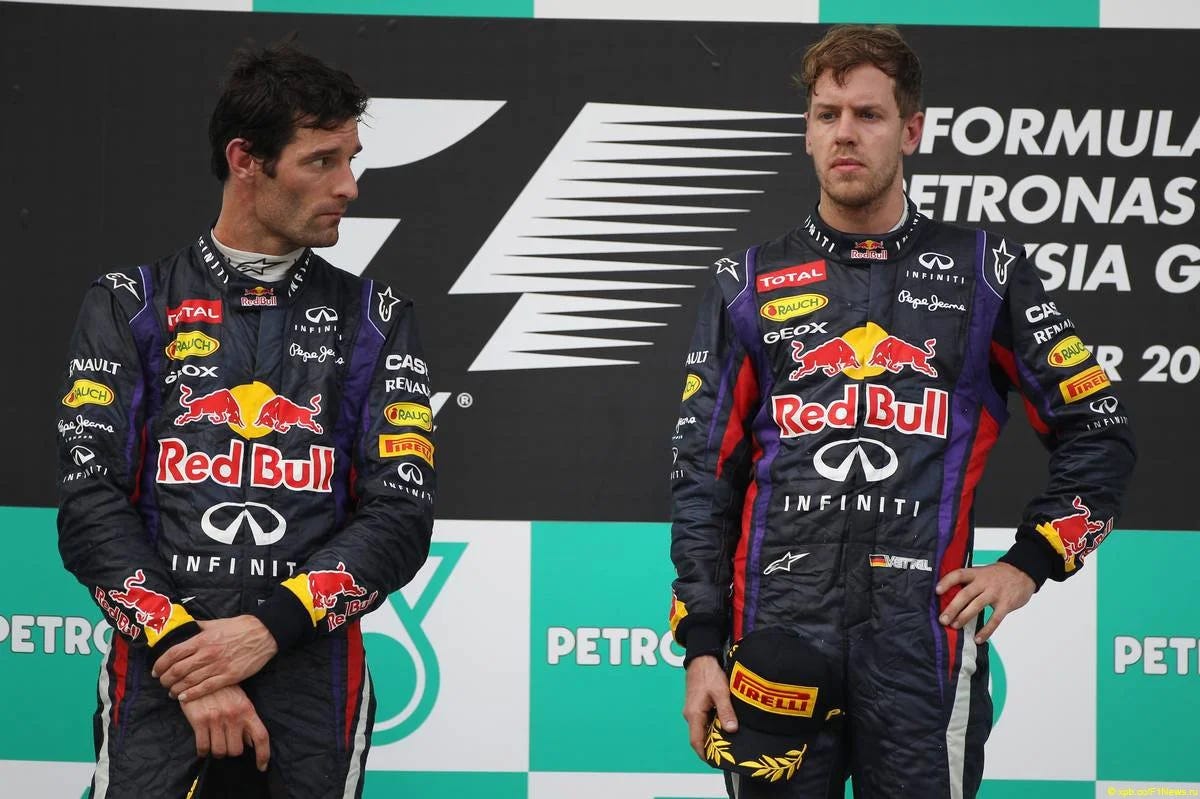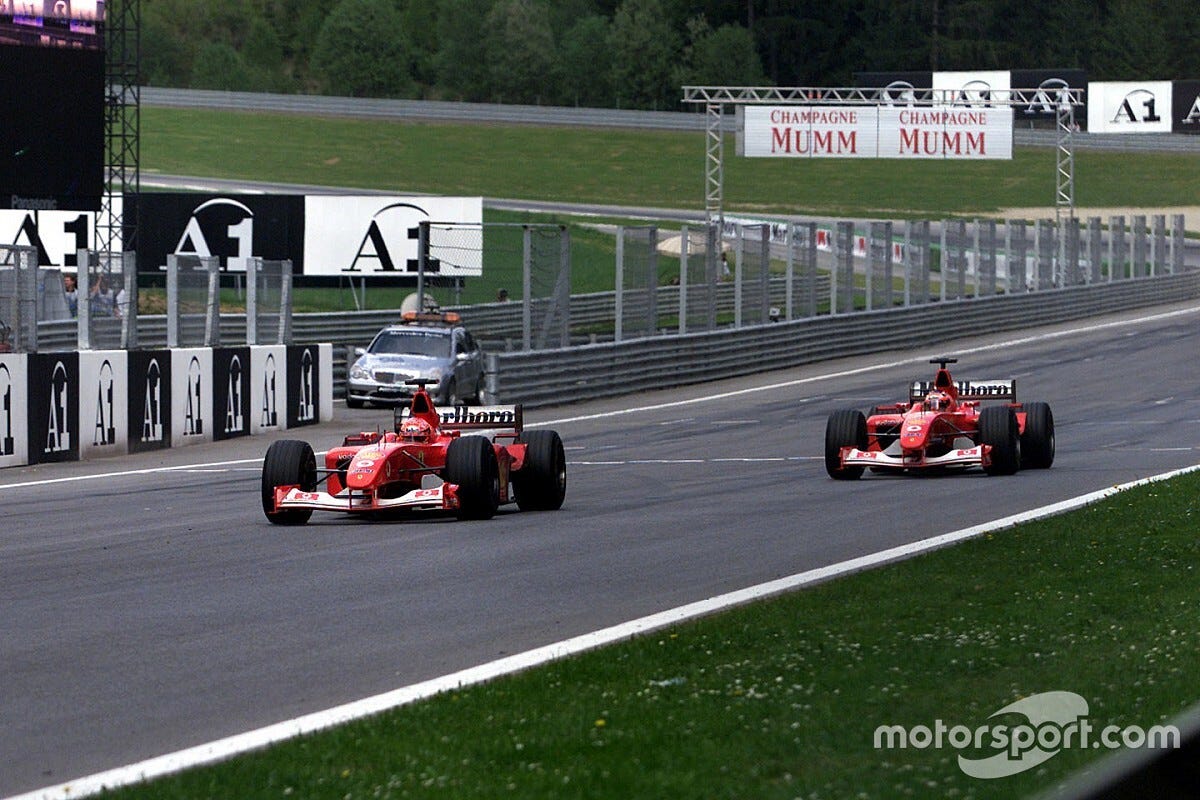TIL #8: Checo Can't Win
Everything you wanted to know about team orders in F1, but were afraid to ask.
Sergio Perez has been having a pretty good season. Five races into 2023, and he’s won two of them, bringing his career tally to 6, and he’s only 14 points behind teammate Max Verstappen in the Driver’s Championship [These facts are now past their sell-by date. As of publishing day for this column, Sergio is now 53 points adrift and has not faired well in the last couple GPs]. At this point, I wish I could go on for two paragraphs about how this is Checo’s year; Max is vulnerable; if Checo can just take the fight to Verstappen and get a couple of lucky breaks along the way, then we could all celebrate F1’s first Mexican world champion! No, Sergio Perez will not be the 2023 F1 Drivers Champion. He won’t be because he’s not allowed to be. You see, at Red Bull, the winner of the championship was decided a long time ago. Red Bull wants Max to win, so Max is going to win. Sergio, despite winning two Grand Prix this year, will not be allowed by Red Bull management to beat Max over the course of a season; that is, of course, assuming that Sergio could beat Max over the course of a season, this is not a foregone conclusion. Welcome to team orders in Formula 1.

There is a caveat to Checo not being “allowed” to win. The Red Bull pit wall doesn’t have omnipotent control over F1 races. This means, there are scenarios that could unfold that would compel Red Bull to switch their pre-determined focus off of Max and throw their support to Sergio in his bid for a title. As seen in 2016 when Nico Rosberg beat Lewis Hamilton to the title. The Mercedes duo won both titles that year, and famously or infamously, there was a “let them race” policy at Mercedes. While Nico had the season of his life, Lewis also experienced a spate of reliability woes that have been exceedingly rare in his career. That year it was too much to overcome, and Nico became champion and immediately retired from the sport. However, those scenario’s are extremely unlikely to unfold, and there would need to be several of these hypothetical scenarios that dish bad luck to Max and good fortune to Sergio, throughout the season. This is not very likely, but it is possible.
The question then arises: why isn't Perez “allowed” to win? In F1, this is what we call team orders. This is a wholly unsporting yet pernicious dynamic that exists in Formula 1 due to the structure of the sport. Teams run two cars in their seasonal campaigns for F1 glory. Each team spends huge amounts of money designing and developing these cars. The teams then hire two mercenaries; they hire drivers whose only purpose in life is to go fast and win F1 championships. This sets up a fragile alliance between teams and drivers. Drivers are a part of a team, but they are also independent contractors. Drivers and teams are loyal to one another right up to the second their interests diverge. Teams can fire drivers at the drop of a hat. As evidenced by the quick exits from Red Bull Daniel Kvyat, Pierre Gasly, and Alex Albon experienced.
To compound this dynamic, you’ve got the relationship between the drivers that needs managing. A team hires two drivers, but those drivers are not necessarily teammates in the traditional sense of the word. The drivers have their individual relationships with their teams, but one of the brutal facts of life in F1 is that if your teammate beats you, repeatedly, in qualifying and in races, you will be shown the door. Adding to this, F1 doesn’t foster the typical camaraderie seen between teammates in other sports. In Formula 1, losing consistently to your teammate results in termination - as Daniel Riccardo found out the hard way at McLaren
With our F1 team in place, with our two ambitious drivers, we now have to look at the F1 points system. 25 points for a win, 18 for second, 15 for third, and on down it goes. If your cars finish 1-2, as Red Bull’s did in Miami recently, then your two drivers now have a six-point gap between them as they fight for the driver’s title. The scoring system for the Constructors Championship is exactly the same, except because you are a single team, your 1-2 finish means a 43-point day in the constructor’s fight. As an F1 team principal, you’ve had a perfect day. Who doesn’t want their cars to finish at the top? One of your drivers has also had a perfect day. Unfortunately, your second driver is now brooding around the garage and desperately looking for performance, error correction, and allies to help them surmount the six-point gap between them and their teammate.
Financial stakes further complicate matters. The Constructors Championship standings determine the teams’ annual prize money, which is crucial for their operation. Each teams finishing position in the Constructors Championship is worth tens of millions of dollars. The constructor’s prize money keeps the lights on for F1 teams. Thus, having both cars finish as high in the points as possible is the priority for all F1 teams. However, it is the Driver’s Championship that gets the glory. The Driver’s Championship is what we all watch, cheer, and jeer over, and generally spend our time pondering.
Here we find ourselves in a tenuous alliance with three parties, two different incentive structures that cause natural rifts in that alliance, and the incentives themselves are offering money and fame, and glory on a global scale. What could possibly go wrong?
Yet another wrinkle comes from the great Michael Schumacher and the architects of his incredible dominance with Ferrari in the early 2000s. Ross Brawn designed and led those teams, with Jean Todt overseeing and protecting his team from the world and the other greedy little powers entrenched within Ferrari. Of the many inventions, techniques, and philosophical approaches to racing that this amazing team gave F1 in those years, one of the biggest lessons demonstrated by Schumacher’s era of dominance was this: If you want to win a championship in modern F1, you throw all of your support behind one driver and get that driver every single possible point. You get yourself a Michael Schumacher or whatever other generational talent happens to be on offer in your era, and you pair that driver with someone who is really good, really consistent, and who will follow orders - and you put those orders in writing, in the second driver’s contract if possible. That driver was in the case of the early 2000s Ferrari — the affable Brazilian, Rubens Barichello.

Team orders have always existed in F1, but it was the Schumacher era that brought those orders out of the shadows and into the harsh light of day with no apologies or subterfuge. The Austrian Grand Prix, 2002, was a dominant weekend in a dominant season for Ferrari. Michael and Rubens had topped the time sheets in every session of the weekend, with Rubens notably leading Michael much of the way, including beating him to pole position. Their victory was never in doubt. On lap 70 of 71, Rubens led Michael as the two of them soared around the track; third place Juan Pablo Montoya was not even in sight on the TV cameras. The announcers, at this point, make the observation that it doesn’t look like there will be any team orders today. Then it happened. Just meters from the finish line Rubens Barichello in the leading Ferrari slows down. At the last possible moment, Michael passes Rubens and takes the win. The announcers are shocked, the crowd hollers and whistles in disgust. It is an ugly scene. The announcer declares, “Michael Schumacher wins the Austrian Grand Prix. He doesn’t deserve to win it. That is outrageous!” The ugliness of this execution of team orders continued to play out on the podium that day. Michael refused to take the top step; he appeared embarrassed at the situation, and rightfully so. Michael nudges Rubens onto the top step, and they share an awkward podium. Rubens continues to try and get Michael to take the top step, but Michael refuses. The German National anthem plays as the Brazilian Barichello stands atop the podium. After that day’s events, team orders that affect the outcome of the race were officially banned in Formula 1. Michael went on to win his fifth championship that year, equalling the great Juan Manuel Fangio. Rubens Barichello never won an F1 driver’s title.
That’s the end of it, right? Team orders are banned, and we’re lucky we don’t have to deal with that anymore. Not exactly. On the heels of the Ferrari debacle in Austria, teams simply got more creative and more obtuse in their execution of team orders. The way things are done now is in the middle of a race, particularly when drivers are on different tire strategies, orders are given for one driver to let another through under the guise of not losing time while your two drivers are on different strategies. Sometimes it comes in the form of a discussion and an agreement before the race. The most explosive example of team orders after Austria 2002 brings us right back to Red Bull.
This time we are at the Malaysian Grand Prix, 2013. Sebastian Vettel is in his prime with three Drivers Championships under his belt and the formidable Aussie, Mark Webber, as his teammate playing the Rubens Barichello role, though fighting it every step of the way. Here, Red Bull got around the team orders ban by instituting a code. That code would go on to define this incident.

Vettel started the race in pole position, but Webber quickly passed him, and the two Red Bulls rocketed off into the distance. The instruction comes over the radio to Seb, “Sebastian, multi-map 2-1, multi-map 2-1, and look after your tires.” Ah! Multi-map 2-1 that must be some setting on the steering wheel, right? No, that was a lazily veiled team order. Mark, driver number 2, is going to win the race; Red Bull bags the 1-2 finish, and everyone is happy. Everyone but the driver coming in second, which in this case is three-time world champion Sebastian Vettel. Vettel ignores the team order. He closes up to the back of Webber and starts attacking him. The radio transmissions come thick and fast. The team is trying to appeal to Seb to stop, while Webber is being consoled that the team isn’t deliberately trying to screw him, “Ok, Mark, he was told!” Seb passes Mark and wins the race. Webber is apoplectic. His relationship with Red Bull and Seb was never the same. Why? Because in the end, Red Bull didn’t do anything at all. They just let it happen because it was ultimately the outcome that they wanted. Seb won, Red Bull won, Mark, lost, and “Multi-21” became a byword in F1 for another scandalous team orders incident.
This all brings us back to where we started. Sergio Perez is Rubens Barichello. Sergio Perez is Mark Webber. Red Bull, unless forced by performance and providence, will not support Sergio Perez becoming an F1 World Champion. Max is their boy, and he always has been.






